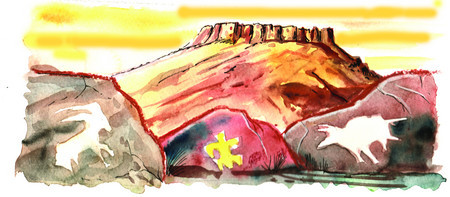Rock art can be found in abundance at Nevada public lands

Nevada’s vast regions of public lands contain hundreds of intriguing sites where its ancient human history is written on the rocks. Over several thousand years, various cultures living in what is now Nevada left a rich heritage of rock art in the form of petroglyphs and pictrographs. Visiting some of the most accessible sites provides glimpses at the mysterious past long before European settlers arrived on this continent.
Exploring these archeological treasures in Nevada provides destinations for dozens of outings throughout the year. The best-known sites lie close to major highways across the state, easily accessible in the family car. More remote sites reached by way of side roads, rough tracks or trails often require high-clearance vehicles, detailed maps and sophisticated global positioning technology.
When you visit a rock art site, remember these remnants are part of a cultural heritage that belongs to all Americans. Irreplaceable relics, they have survived the elements for hundreds and in some cases thousands of years, yet they are easily damaged. Visitors should take photos, but resist touching the rock art, as the oils from our skin can damage them. Never climb over them, mark them in any way or remove them. Damage or theft falls under protective state and federal antiquities laws with fines and jail time.
This fragile legacy of cultural remnants provides clues about the people who left them for others to interpret. They indicate the ancient artists were people who lived in harmony with their environment and developed detailed knowledge of it. The rock art most often occurs near water sources, game trails and overland routes vital to people living off the land. Some sites occur in areas with traditional religious significance. Others align with celestial events such as the equinoxes, indicating the early people closely observed the night skies.
Several of Nevada’s best-known rock art sites lie within easy driving distance of Las Vegas on public lands. Red Rock Canyon National Conservation Area contains petroglyphs among many of its trails, as well as in more remote areas. As yet undeveloped, Sloan Canyon National Conservation Area south of Las Vegas was set aside primarily to prevent destruction of many panels of petroglyphs by suburban development. Nevada’s largest and oldest state park, Valley of Fire protected petroglyphs in several locations, including Atlatl Rock and Mouse’s Tank. Far-flung regions of Clark County with concentrations of petroglyphs include Keyhole Canyon off U.S. 95 south of Railroad Pass, Grapevine Canyon and Hiko Springs off Highway 163 near Laughlin, and Whitney Pockets south of Mesquite in the Gold Butte region.
Neighboring Lincoln County boasts enough significant rock art sites to have a new printable guide on its Web site. Some are just off major routes such as U.S. 93 through the Pahranagat Lakes area near Alamo, in the White River Canyon along Highway 318 and in the Rainbow Narrows south of Caliente, an area badly damaged by past flash flooding but in use by locals.
Other sites scattered across Nevada lend themselves to longer trips during the warm seasons of the year. The Bureau of Land Management’s Grimes Point Archaeological Site near Fallon contains hundreds of glyph panels on boulders along the Grimes Point Trail, named in 1978 as a National Recreational Trail. The Hickison Petroglyph Site east of Austin on U.S. 50 lies near a popular campground. Hikers and bikers using the Lagomarsino Trail near Virginia City pass through a significant petroglyph site.
Since complete protection of hundreds of rock art sites is impossible, the Nevada State Historical Preservation Department sponsors a volunteer training program to help archaeologists list and monitor sites. Participants in the Nevada Archaeological Site Stewardship Program receive several hours of free training covering laws, procedures, identification and safety, as well as a baseline visit to a site with an agency archaeologist. When trained, volunteers visit their sites at least four times a year and report upon its status. Nevadans interested in becoming a volunteer steward should call the preservation office to 486-5011.
Margo Bartlett Pesek’s column appears on Sundays.